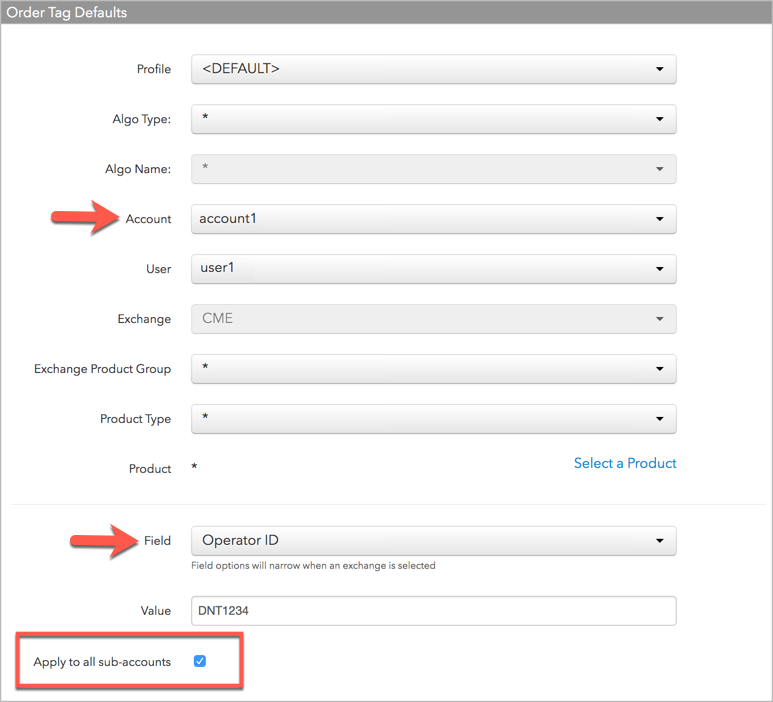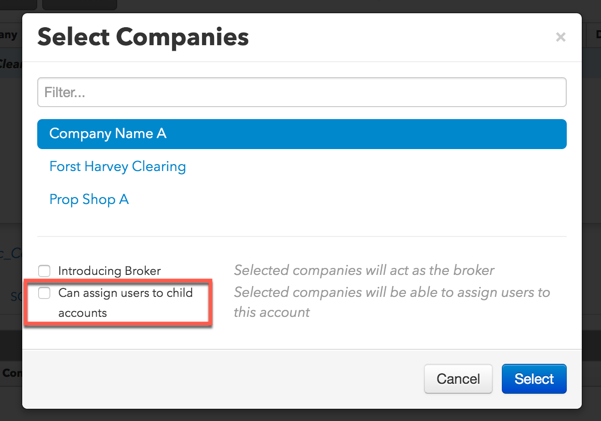Users
User sharing
At the company level, sharing a user with another company allows the sharing company to create users and maintain ownership of the shared user's day-to-day setup and user risk limits. The company with whom the user is shared creates, manages, and assigns the accounts to the shared user and maintains control of the risk settings on those accounts. For example, a buy-side firm can share users with an FCM, who can then assign accounts directly to those users, and can even control market data settings if needed. The buy-side is just responsible for creating users accounts.
User sharing rules
If you shared a user with another company or if another company's user is shared with your company, consider the following restrictions on viewing or changing the user's settings or profile:
- Shared users cannot be deleted by the companies they're shared with, but they can be marked Inactive or set to Disable Trading. These settings only apply when the user tries to trade with the company that set the settings.
- A company can choose to pay for a client user's login and trading activity fees by selecting "I agree to sponsor this user". If the other company has agreed to pay these fees themselves, sponsoring is optional. Otherwise it is required.
- A shared user's contact information can only be viewed by their own company.
- The sharing company can view all of their user's accounts, including accounts assigned to the user by the shared-with company. However, the shared-with company can only view the accounts they've assigned to the user.
- A shared user's product groups, limits, and credit can only be set by the sharing company.
User sharing: Client impact
As a client, the user sharing functionality allows you to trade with multiple brokers and trading firms while remaining a member of your own firm. You can continue to use the same Trade application workspaces, order book, audit trail, etc. Your user risk limits are configured by your own company, but the account risk limits are provided by and managed by the company that you are being "shared" with.
However, if you leave your firm or company in the TT system to become a member or employee of another company, your workspaces, accounts, and positions remain with the company you are leaving. In this case, you would accept a second invitation from the new company to become an employee or member of that company.
User sharing: Company administrator impact
As a company administrator, you can share your company users with another company by using the Company Relationships section on the Users | Profile tab in Setup.
Note: Unless they are leaving their firm to trade with yours, do not use the Setup invitation process to invite users in other companies to trade with your firm.
Shared account and user interactions
In order to provide their client with access to a market, companies may need to share a user with another company. In this case, the shared-with company will assign an account with the market's credentials to the shared user, then share that account "back" to the shared user's company.
However, a company may want to lock certain user fields (e.g., Operator ID) on the shared account or prevent companies from adding users to the related child accounts. As an administrator, there are two settings you can use when sharing an account with a user who has been shared with your company:
- Can assign users to child accounts — Prevents another company from adding users to the child accounts of a shared account. Uncheck this setting to prevent users from being assigned to the child accounts. By default, this setting is checked and users can be assigned. This option is available on the Accounts | Sharing tab.
- Apply to sub-accounts — Can be applied to subscriber fields to lock these values on the child accounts of a shared parent account. This setting is available on the Order Tag Defaults tab in the left navigation pane for a selected profile.
Account sharing configuration
When the Can assign users to child accounts setting is unchecked on a shared account, consider the following:
- When acting as the introducing broker when sharing an account (Introducing Broker setting is checked), then Can assign users to child accounts cannot be unchecked. This setting is checked by default.
- The shared-with company cannot assign users to child accounts of the shared parent account. They also cannot move child accounts with assigned users to the shared account tree.
- Risk limits can be set for the child accounts that the shared-with company creates. However, the sharing company maintains full control over users and parent level account limits.
Example: Sharing an account with a shared user
In this example, a client firm (Client-A) shares one of their users (user1) with a broker (Broker-B) in order to provide "user1" with access to CME:
- Client-A shares "user1" with Broker-B, who is the owner of the CME market credentials.
- Broker-B assigns "account1" to "user1".
Note: Using Order Tag Defaults, Broker-B sets the "Operator ID" field on account1 and checks the Apply to all sub-accounts checkbox to ensure that any child accounts created under "account1" will send the Broker-B Operator ID to CME.

- Broker-B shares "account1" with Client-A.
Note: When sharing the account, Broker-B unchecks the Can assign users to sub-accounts setting to ensure that only "user1" can trade with this account.

- Client-A creates child accounts "child1" and "child2" from "account1". The child accounts inherit Client-A's "user1" as well as the CME routing credentials from Broker-B. The Broker-B "Operator ID" is routed to the exchange on all orders submitted with the child accounts.